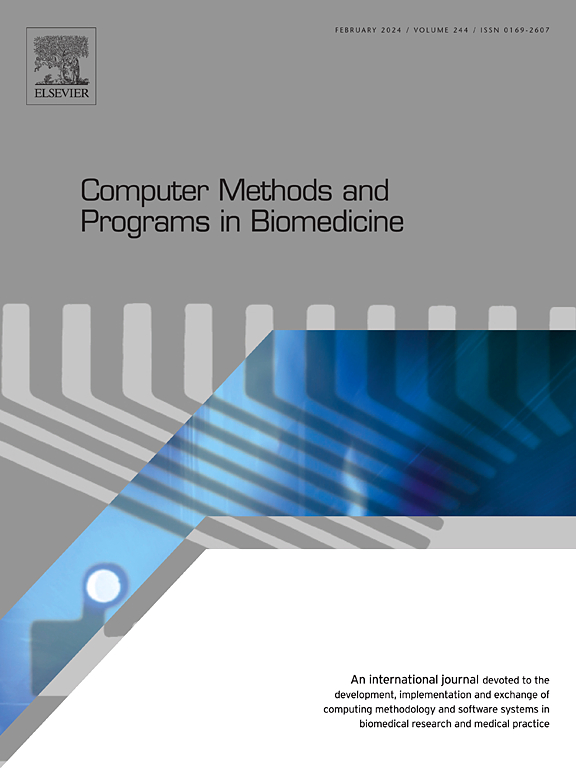Unraveling the tumor-microenvironment through a radiogenomic-based multiomic approach to predict outcomes of immunotherapy in non-small cell lung cancer
IF 4.9
2区 医学
Q1 COMPUTER SCIENCE, INTERDISCIPLINARY APPLICATIONS
引用次数: 0
Abstract
Background
The tumor microenvironment (TME) plays a critical role in influencing immune checkpoint inhibitor (ICI) therapy outcomes in advanced non-small cell lung cancer (NSCLC). This study aimed to develop a radiomics model reflecting an ICI-favorable TME based on whole transcriptome sequencing (WTS).
Methods
This multi-center retrospective cohort study included training (n = 120), internal validation (n = 319), and external validation (n = 150) cohorts of advanced NSCLC patients who received ICI as first- or second-line therapy. The radiomics model (rTME) was developed based on the TME score, which reflected ICI-favorable immune cell compositions. The model’s performance was assessed using the C-index, and survival outcomes were also evaluated.
Results
In the training cohort, high rTME scores were associated with significantly prolonged progression-free survival (PFS) (median 4.1 vs. 2.9 months, p = 0.024) and overall survival (OS) (median 15.0 vs. 8.4 months, p = 0.030). Similar trends were observed in the internal validation cohort for PFS (median 3.3 vs. 2.1 months, p = 0.004) and OS (median 13.9 vs. 7.3 months, p = 0.004), as well as in the external validation cohort for OS (median 15.5 vs. 7.3 months, p = 0.008). Integrating clinical variables improved predictive accuracy in both the training and internal validation cohorts.
Conclusion
Our radiomics model, reflecting the ICI-favorable immune cell expression in the TME, showed a positive association with ICI outcomes in NSCLC patients. Integrating radiomics and clinical variables enhances prognostic accuracy, demonstrating the model’s potential utility in guiding ICI therapy decisions.
通过基于放射基因组学的多组学方法揭示肿瘤微环境,预测非小细胞肺癌免疫治疗的结果
肿瘤微环境(TME)在影响晚期非小细胞肺癌(NSCLC)免疫检查点抑制剂(ICI)治疗结果中起着关键作用。本研究旨在建立一个基于全转录组测序(WTS)的放射组学模型,以反映ci有利的TME。方法本多中心回顾性队列研究包括培训(n = 120)、内部验证(n = 319)和外部验证(n = 150)接受ICI作为一线或二线治疗的晚期NSCLC患者队列。放射组学模型(rTME)是基于TME评分建立的,它反映了ici有利的免疫细胞组成。使用c指数评估模型的性能,并评估生存结果。结果在训练队列中,高rTME评分与显著延长无进展生存期(PFS)(中位4.1个月vs 2.9个月,p = 0.024)和总生存期(OS)(中位15.0个月vs 8.4个月,p = 0.030)相关。在PFS的内部验证队列(中位数3.3个月vs. 2.1个月,p = 0.004)和OS(中位数13.9个月vs. 7.3个月,p = 0.004)以及OS的外部验证队列(中位数15.5个月vs. 7.3个月,p = 0.008)中也观察到类似的趋势。整合临床变量提高了训练和内部验证队列的预测准确性。我们的放射组学模型反映了TME中ICI有利的免疫细胞表达,显示出与非小细胞肺癌患者ICI预后呈正相关。整合放射组学和临床变量可提高预后准确性,证明该模型在指导ICI治疗决策方面的潜在效用。
本文章由计算机程序翻译,如有差异,请以英文原文为准。
求助全文
约1分钟内获得全文
求助全文
来源期刊

Computer methods and programs in biomedicine
工程技术-工程:生物医学
CiteScore
12.30
自引率
6.60%
发文量
601
审稿时长
135 days
期刊介绍:
To encourage the development of formal computing methods, and their application in biomedical research and medical practice, by illustration of fundamental principles in biomedical informatics research; to stimulate basic research into application software design; to report the state of research of biomedical information processing projects; to report new computer methodologies applied in biomedical areas; the eventual distribution of demonstrable software to avoid duplication of effort; to provide a forum for discussion and improvement of existing software; to optimize contact between national organizations and regional user groups by promoting an international exchange of information on formal methods, standards and software in biomedicine.
Computer Methods and Programs in Biomedicine covers computing methodology and software systems derived from computing science for implementation in all aspects of biomedical research and medical practice. It is designed to serve: biochemists; biologists; geneticists; immunologists; neuroscientists; pharmacologists; toxicologists; clinicians; epidemiologists; psychiatrists; psychologists; cardiologists; chemists; (radio)physicists; computer scientists; programmers and systems analysts; biomedical, clinical, electrical and other engineers; teachers of medical informatics and users of educational software.
 求助内容:
求助内容: 应助结果提醒方式:
应助结果提醒方式:


